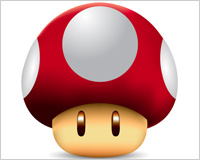 In this post, we’re going to learn about a bit about Illustrator's Mesh tool.
It’s one of the hardest tools to master in Illustrator, but if you want to achieve a 3-D look in your illustrations, you have to really understand how to use this tool properly.
We’re going to create a Super Mario-style mushroom in order to better understand how to use this tool using a real life example.
When you get to the end of the tutorial, please share your results with us. And do let us know if you ran into any trouble along the way.
In this post, we’re going to learn about a bit about Illustrator's Mesh tool.
It’s one of the hardest tools to master in Illustrator, but if you want to achieve a 3-D look in your illustrations, you have to really understand how to use this tool properly.
We’re going to create a Super Mario-style mushroom in order to better understand how to use this tool using a real life example.
When you get to the end of the tutorial, please share your results with us. And do let us know if you ran into any trouble along the way.
Step 1
Let’s open Adobe Illustrator and create a canvas that is 25 × 11 cm (9.84 × 4.33 inches), in RGB, and at 300 DPI. Let’s start on the left side of the canvas.






Step 2
Using the Selection tool (L), select everything except the perfect circle. Hold them, and press Shift, and then drag across, which will duplicate the elements.




Step 3
Before we can start with the Mesh tool, we have to choose the main colors of the mushroom, set them as fills, and disable all strokes. I chose four colors… Beige for the face (R:233 G:201 B:126)…




Step 4
Like me, you’ve probably used the Mesh tool only a few times, if ever. Mastering a tool is hard if you don’t know the basics, so let’s try a simple exercise before proceeding. First, create a perfect beige circle using the Ellipse tool (L) + Shift.






Step 5
Before starting on the mushroom, lock the other elements so that you don’t accidentally select them with the Lasso tool (Q). But lock one element at a time (face, then head, then eyes, etc.). Let’s begin with the face. Make a net using the Mesh tool (U). Try to make it symmetrical.


Step 6
Use the Mesh tool (U) on just one of the eyes. We’ll duplicate it later to save time.



Step 7
Use the Mesh tool (U) on the head. Making this grid will be a bit tougher because it’s bigger, but it doesn’t have to get too complex.


Step 8
I decided not to use the Mesh tool on the circles, because they are fairly simple shapes and have way less light to be managed. Instead, I used the Gradient tool (G) to get a white-to-gray radial gradient, and I just adjusted its direction and amount.


Step 9
For a final touch, I added a simple ellipse to the bottom using the Ellipse tool (L). Then, using the Gradients panel, I applied this fading black gradient and adjusted its amount and shape. Quite simple, and better than a Gaussian blur to achieve the same effect.

The Result
Well, I hope you had a great time following this tutorial and learning more about the Mesh tool.
Read Next
15 Best New Fonts, July 2024
Welcome to our monthly roundup of the best fonts we’ve found online in the last four weeks. This month, there are fewer…
By Ben Moss
20 Best New Websites, July 2024
Welcome to July’s round up of websites to inspire you. This month’s collection ranges from the most stripped-back…
Top 7 WordPress Plugins for 2024: Enhance Your Site's Performance
WordPress is a hands-down favorite of website designers and developers. Renowned for its flexibility and ease of use,…
By WDD Staff
Exciting New Tools for Designers, July 2024
Welcome to this July’s collection of tools, gathered from around the web over the past month. We hope you’ll find…
3 Essential Design Trends, July 2024
Add some summer sizzle to your design projects with trendy website elements. Learn what's trending and how to use these…
15 Best New Fonts, June 2024
Welcome to our roundup of the best new fonts we’ve found online in the last month. This month, there are notably fewer…
By Ben Moss
20 Best New Websites, June 2024
Arranging content in an easily accessible way is the backbone of any user-friendly website. A good website will present…
Exciting New Tools for Designers, June 2024
In this month’s roundup of the best tools for web designers and developers, we’ll explore a range of new and noteworthy…
3 Essential Design Trends, June 2024
Summer is off to a fun start with some highly dramatic website design trends showing up in projects. Let's dive in!
15 Best New Fonts, May 2024
In this month’s edition, there are lots of historically-inspired typefaces, more of the growing trend for French…
By Ben Moss
How to Reduce The Carbon Footprint of Your Website
On average, a web page produces 4.61 grams of CO2 for every page view; for whole sites, that amounts to hundreds of KG…
By Simon Sterne
20 Best New Websites, May 2024
Welcome to May’s compilation of the best sites on the web. This month we’re focused on color for younger humans,…














